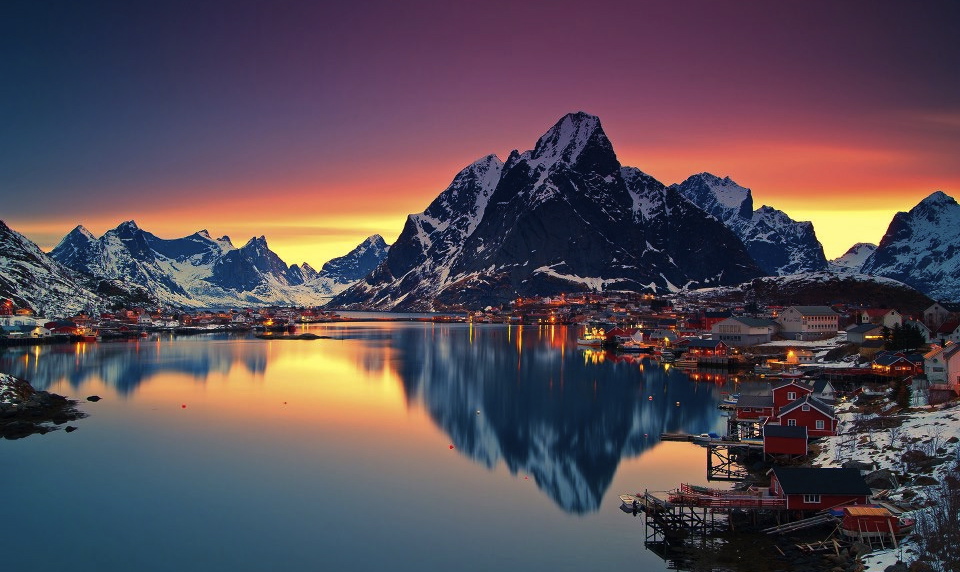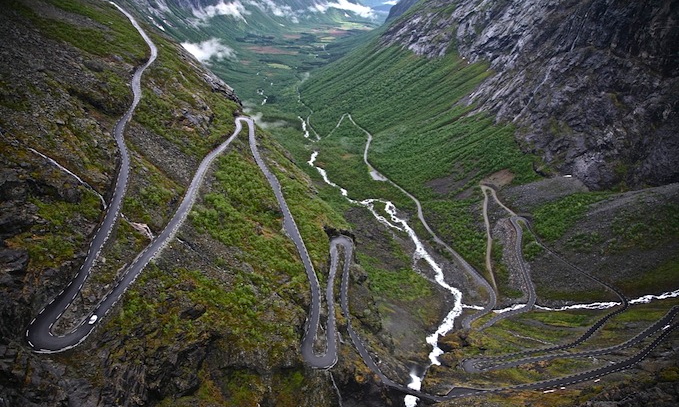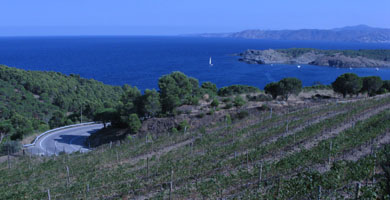On the Edge of Europe: NORTHERN NORWAY
Henrik Lomholt Rasmussen explores the far reaches of Norway and discovers his favorite spot above the Arctic Circle.
Our journey north begins in the town of Hammerfest on the Norwegian mainland. The town lies 600 miles north of the Arctic Circle and is situated on the same latitude as the northernmost point in Alaska. After checking in at the contemporary harbourside Rica Hotel, we walk up a steep path that takes us to the top of a hill with a magnificent view of Hammerfest and its harbor that is ice-free all year due to the Gulf Stream and surrounding fjords and mountains.
One of my first discoveries here is I notice the town´s coat of arms shows a polar bear, although the only one I find in Hammerfest is a stuffed creature at the town’s combined tourism office and museum. I guess there is some tangent though, because I discover you can sign up for a membership here in the Polar Bear Club – that group of over 200,000 hardy souls who venture into cold winter waters to swim. But first a little background on Hammerfest – and polar bears. The town was originally a trading post that was given market town rights in 1789. One hundred fifty years later the town was granted its coat of arms – and the polar bear was chosen as its symbol for the fishing in the polar seas north of Norway. Nowadays, Hammerfest is more reminiscent of an Alaskan goldrush town, thanks to recent large finds of liquid natural gas that are being refined on an island just half a mile from the coast.
Reindeer Stew
Behind us lies Mikkelgammen, a traditionally built Sami cabin clad with peat on the outside. Inside Solveig Aslak serves reindeer stew cooked over an open fire with Portuguese red wine while she recounts stories of the Sami people. “There are around 30,000 Sami in Norway. Others live in the north of Sweden, Finland and Russia. Ten percent of the Norwegian Sami live on raising reindeer. The rest have integrated into modern society. Even though our history in Norway can be traced more than 4,000 years back, some still consider us as an unwanted minority,” says Aslak before she starts to joke and chant in Sami language. Chanting is a Sami tradition and a way of telling stories about literally everything. When we leave Solveig Aslak and Mikkelgammen at 11pm to return to the hotel, there is no need for street lights or torches – in the middle of August there is still plenty of light in late in the evening. This is, after all, the land of the Midnight Sun.
Cruising on Rypøy
The next morning we make our lunch packs at the hotel’s breakfast buffet, before the two-minute walk to the harbor where we board the catamaran ferry “Rypøy.” Our destination is Akkarfjord, a fishing village on the northern part of Norway’s fourth largest island, Sørøya, but underway “Rypøy” calls at small landings where a few locals and hikers disembark. At one of the small ports, the ferry’s crane unloads a six wheeler ATV. With a cigarette dangling from her mouth, a woman in her thirties mounts the vehicle and drives off, leaving us in her wake.
In Akkarfjord, one of the village’s inhabitants waves to his two grandchildren as they depart on the ferry. “They love to stay here. So do I. I was born here and came back six months ago after having spent 22 years on the mainland. Now I am working at the fish factory and play a little guitar every now and then. I used to play in a band called Island. We played symphonic heavy metal with island inspiration,” says 43-year-old Frode Jakobsen before walking back to his house with his dogs, Chanie and Blackie.
Cloudberries, Kjøttvikfjellet and Swimming in the Barents Sea

We head up in the hills behind Akkarfjord where we are met by a fantastic view over an Arctic landscape with low vegetation, deep blue lakes and rock islands in the Barents Sea. In order to reach our goal – Kjøttvikfjellet – we leave the unpaved road and start a steep walk over Trollbukfjellet. There is no marked route yet, but with a guide, a map, a compass, and nice weather, the only real challenge becomes our level of fitness. Regardless of what kind of shape we’re in, the walk is tough but everyone agrees it’s worth it after we arrive at our destination – Kjøttvikfjellet. Arriving, we are greeted with some amazing vistas, including 1,000 feet of free fall. That is what you face if you look over the edge of Kjøttvikfjellet, a giant boulder here on Sørøya, some 400 miles north of the Polar Circle. Looking up, all you see is sea and more sea.
“Next stop is Greenland,” says Knut Arne Iversen, the tall Norwegian who is one of two guides that on this warm August day has taken our group of hikers to the brink of the abyss. Apart from being beautiful and grandiose, it’s also very windy. I struggle as my camera strap is almost blown over my head, but above me, a pair of sea eagles deftly dance in the wind. You can’t miss Kjøttvikkfjellet – it’s marked by a 40-foot tall rock cairn erected in 1893. Hidden at its foot beneath a rock a visitors’ book awaits our signatures. After having scribbled in the book, studied the views and some grazing reindeer, it is time for eating our lunch packs on a spot with protection from the wind as well as sun. A rare visitor here, the sun is particularly welcome. “Last summer we had two days with sunshine,”says Iversen as he takes a sip of his water bottle that he filled from a nearby stream. “The weather can change from sunny, clear and 70 degrees to heavy fog and 40 Farenheit in five minutes.”
After lunch, Iversen serves coffee and lefser, a kind of pancake. They taste good, but the wild cloudberries and blueberries are even better. Next, it’s time for a swim as Iverson and some of the brave hikers throw themselves into the turquoise water at the Bay of Gamvik. Despite a water temperature of 45F and snowcapped mountains nearby, we enjoy a beach holiday at the Barents Sea. “It only needs a beach bar,” adds a of the hiker. Back in the village, the head teacher Alvin Vaséli has the perfect offer after five hours of hiking. “Sit down and have a beer,” he says, enjoying the sun in front of his house with his German girlfriend and colleague Christine Witt who left Berlin for Akkarfjord four years ago. Sipping a cold Arctic Pilsner, the couple talks about teaching the school’s nine pupils and Akkarfjord as a center of growth. “Seventy to eighty people live here compared to fifty just four years ago. That is relatively big growth,” continues Vaséli, He says the newcomers are creative people with a lot of ideas and flexible jobs. Some are setting up a gallery, others a restaurant and a tourist information office, while he is offering basic accommodation for travelers at the school. “It’s only five minutes by boat to Hammerfest. From there it is a five hour flight to Berlin.”
The World’s Most Northern Town
That night it’s early to bed at the Rica Hotel. Next morning, we depart at 7.45am with the Hurtigruten’s cruise ship “Trollfjord.” The destination is Honningsvåg – a town on the mainland that due to a large growth in the number of inhabitants was officially upgraded from a village to a town in 1996, much to the chagrin of Hammerfest. “Honningsvåg now calls itself “The World´s Northernmost Town.” That slogan used to be ours,” bristles Iversen while he and I are enjoying life in one of Trollfjorden´s two deck jacuzzis with panoramic views to sunny skies and steep hillsides.
At noon the vessel calls in at Honningsvåg. Lunch consists of cod tongues, a Norwegian delicacy that are deep-fried and served with a boiled potato and a bit of carrot salad. After lunch there is time to peek into a Samish souvenir shop. Among reindeer hides, antlers and crocheted dolls, 79-year-old Marit and her 12-year-younger friend, Berit, are busy knitting and drinking coffee. ”We live in Karasjokk a few hundred miles south but move here in the summer when the younger generations follow their reindeer herds. We help with processing the hides and look after the shop,” explains Marit, dressed in a traditional colorful Samish dress.
North of North Cape
After meeting with two of the older representatives of Norway´s 20,000 Samis, it’s off to North Cape in a hired car. After an hour’s drive and 12 miles from what is argued to be Europe’s northernmost point where the Norwegian Sea meets the Barents Sea, it is time to stretch our legs. The aim of the hike is to reach Knivskjellodde – Europe’s northernmost point. “Knivskjellodde is situated a bit more to the north than North Cape, but the latter gets all the attention because the setting is more spectacular,” Iversen explains. This is confirmed a few hours later when we reach Knivskjellodden. The barren landscape and the mandatory reindeer add to the setting but, nevertheless, it is pretty hectic given the desolate landscape. Some hikers have pitched a tent on the beach. They are being followed by two young Swiss women who also are planning to stay overnight a bit further north of North Cape. The same goes for three Danes that pass us on mountain bikes.
 We have a coffee before returning to the car. Shortly before arriving at North Cape, we slalom drive between reindeer that sedately trudge along the asphalt, only to abruptly stray across the road every now and then. While we avoid hitting any reindeer we cannot escape paying a $40 entry fee to the North Cape. “The fee is criticized by some because they think it conflicts with the Norwegian allemandsret (meaning: roam and camp),” explains our guide Elisabeth Müller. Half an hour of watching the sunset at North Cape ends up being enough for us. While pleasant enough, after yesterday’s adventure at the island of Sørøya, North Cape reminds us of a tourist trap with its big visitor´s center, souvenir shop and restaurant. My big revelation here in the land of the Midnight Sun, cod tongues and road warrior reindeers? Visit North Cape so you can say you have been there, but make Sørøya your real destination and discover what Northern Norway really has to offer.
We have a coffee before returning to the car. Shortly before arriving at North Cape, we slalom drive between reindeer that sedately trudge along the asphalt, only to abruptly stray across the road every now and then. While we avoid hitting any reindeer we cannot escape paying a $40 entry fee to the North Cape. “The fee is criticized by some because they think it conflicts with the Norwegian allemandsret (meaning: roam and camp),” explains our guide Elisabeth Müller. Half an hour of watching the sunset at North Cape ends up being enough for us. While pleasant enough, after yesterday’s adventure at the island of Sørøya, North Cape reminds us of a tourist trap with its big visitor´s center, souvenir shop and restaurant. My big revelation here in the land of the Midnight Sun, cod tongues and road warrior reindeers? Visit North Cape so you can say you have been there, but make Sørøya your real destination and discover what Northern Norway really has to offer.
Northern Norway Travel information
Getting There: Hammerfest is 827 miles north of Oslo, the Norwegian capital. It is possible to drive all the way but it is easier and faster to go by plane. The Norwegian airline company, Widerøe, has several weekly flights between the two cities.
Getting Around: An adult ticket with the ferry Hurtigruten from Hammerfest to Honningsvåg costs $60 while the price for a car on the same journey is $66. Avis and Hertz are some of the car rental agencies that are represented in Hammerfest.
Free or cheap lunch packs: If you go hiking, ask a waiter for permission to make a lunch pack at the hotel’s breakfast buffet. Some will require a nominal fee others, but the Rica Hotel in Hammerfest, will let you make your lunchpack for free.
Sun screen and warm clothes: The weather in Northern Norway is unpredictable so bring sun screen as well as warm clothes, hiking boots, fishing tackle and other outdoor equipment.
Dining in Hammerfest: Peppe’s Pizza on the harbor charges $42 for a B’n’B-pizza with beef, french fries and Bearnaise sauce. Add another dollar and Restaurant Skansen on Rica Hotel will serve you Norwegian salmon or entrecôte with pommes duchesses, red wine sauce and vegetables. For an extra $8 you can have a reindeer steak or freshly caught halibut.
*And yes, these prices are in US dollars.
Currency: Norwegian krone (1 NOK = 0.16 cents)
For more information, go to www.visitnorway.com
Latest posts by Henrik Lomholt Rasmussen
- On the Edge of Europe: NORTHERN NORWAY - August 27, 2012









